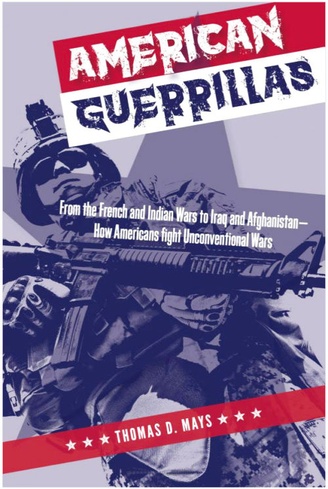A
conventional army loses if it does not win. The guerrilla army wins
if it does not lose.
– Henry Kissinger
###
A new military history links the infamous Indian Island Massacre
to the long tradition of American guerrilla warfare, from at least
the early 17th century to Iraq and Afghanistan.
Secrecy, stealth, surprise and hit-and-run: these were the classical guerrilla tactics and organization used in the 4 a.m. Sabbath slaughter at Tuluwat on Duluwat Island Feb. 26, 1860, according to military historian and Humboldt State History Professor Thomas A. Mays.

Humboldt
Bay white men, probably including ranchers and wealthy landowners,
“formed a guerrilla unit with a single purpose: killing Indians,”
Mays asserts in his latest book, American Guerrillas, from the
French and Indian Wars to Iraq and Afghanistan: How Americans Fight
Unconventional Wars.
“Avoiding gunfire, which would have alerted the populace, the attackers massacred everyone within reach – the majority of whom were women and children – using mostly hatchets, axes and knives,” Mays recounts. Casualty estimates range widely from 80 to 250 people in the racist atrocities at Duluwat and other Humboldt Bay locations in 1860.
Mays’ new 270-page history documents how the Duluwat terror typified the American tradition of frontier guerrilla warfare and the genocide of Native Americans. The author explains that fighting in the West had been going on long before the Civil War broke out in April 1861. The U.S. regular army had garrisoned forts in the region decades earlier. After the attack on Fort Sumter off Charleston, South Carolina, soldiers redeployed east, leaving western military outposts in the power of local authorities.
“Many settlers resented the army’s presence because at times soldiers were bound to protect the rights of Natives and their property,” Mays writes.
The Gold Rush had brought throngs of settlers to Humboldt Bay and the rest of Northern California. When state and federal troops decamped from Fort Humboldt for Civil War battlefields, local militias mounted guerrilla raids “aimed at rounding up as many Natives as they could,” according to Mays. They either cut the Indians down with the utmost brutality or herded them into ghettos – euphemistically called reservations – farther from the coast.
In an interview last week in Eureka, not far from where the 1860 extermination was carried out, Mays explained, “When I use the term guerrilla, I mean a military or paramilitary organization that may or may not be sanctioned by the government. It’s organized butchery” by the equivalent of a vigilante group.
Defenseless civilians – meaning women, children and the elderly – are considered combatants and dispatched accordingly.
The term guerrilla (from the Spanish meaning “little war”) gained new currency during Napoleon’s Peninsular War with Spain, Portugal and Britain for control of the Iberian Peninsula, from 1807 to 1814.
However, Mays points out, the history of guerrilla warfare is as old as recorded history. The first known theorist is a 6th century BCE Chinese general and military expert, Sun Tzu, widely credited with the authorship of an ancient classic, The Art of War. Applying Taoist principles, Sun developed a military philosophy that enshrined spying, deception, “extreme subtlety,” harmony between soldiers and officers and a sophisticated understanding of the psychology of conflict.
Mays said that in every account of the Indian Island massacre he has researched – from the contemporary reporting of journalist, novelist and poet Bret Harte, who lived for a time in Arcata (née Union), to Benjamin Madley’s definitive 2016 An American Genocide: The United States and the California Indian Catastrophe — the Indian Island marauders “wanted complete and total surprise,” not hand-to-hand combat with Wiyot, Eel River and Mad River Native American men. They had gathered in large numbers the day before the massacre for their yearly World Renewal ceremonies. Nearly all had departed before the attack, hence the high mortality rate of women and children.
It’s entirely likely that the Humboldt guerrillas numbered as many as 75 or more because their attacks were not confined to Duluwat Island, Mays noted: “They attacked every village in the bay.” Fatality estimates “are all over the place,” he cautioned, depending on divergent historical accounts.
He referred a reporter to Madley’s exhaustive American Genocide, which records that in less than a week after the Feb. 26 slayings, guerrilla squads had murdered as many as 285 Indians or more in five separate bloodbaths.
In a chapter titled “Perfecting the Killing Machine,” Madley points out that fishing season had ended by early February. Many whites had time on their hands and they set up a faction christened the Humboldt Cavalry. According to contemporary sources, the faction “resolved to kill every peaceable Indian man, woman and child in this part of the country.”
The excuses were that Native Americans were stealing or killing the settlers’ stock or that the indigenous peoples who had survived the Red Cap War (or Klamath War) of the mid-1850s had infiltrated the ranks of their brethren in Humboldt, allegedly looking for trouble.
The ranchers’ claims of stock losses figure in a story that repeats itself over and over across the state of California, Mays said, and it is retold in detail in American Genocide.
In the his words, “A rancher has a couple of stock killed and they respond by killing and wiping out a village, completely out of proportion to what’s going on. I would say what was going on here was pure terrorism.”
The official Yurok website says the Red Cap Indians, “believed to be a mix of tribal groups,” initiated a vigilante revolt against settlers in 1855. “The government was able to suppress the Red Cap Indians and regained control over the upper Yurok Reservation,” according to the Yurok online account.
American Guerrillas lays out the predicate for the guerrilla assaults in 19th century California with what happened in 17th century New England.
On one occasion during the Pequot War of 1634 to 1638, the Massachusetts Bay militia burned the two empty Native American villages to the ground, carried off the crops for winter sustenance and destroyed what could not be transported. Untold numbers of Indians were sold into slavery in the West Indies by a colony founded by Governor John Winthrop, who had proclaimed the settlement “a City on a Hill” to all peoples. Ironically, Harvard had been founded as a seminary in 1636.

Dr. Thomas Mays
Mays
says the conflict between the English colonists of Massachusetts Bay
and their Narragansett and Mohegan allies versus the Pequots brought
about a new form of warfare called “extirpative” – scorched
earth attacks against civilian targets. The method would be repeated
two and a half centuries later in Humboldt.
When a New England guerrilla band or militia could not find the enemy, a village would be destroyed instead, along with houses, crops, cattle and any other resources.
The Pequot War was of crucial significance, Mays writes, because “it would color American guerrilla warfare throughout the era,” stretching from Northern California to the Civil War and thence to the Spanish-American War (Guerra Hispano-Americana) of 1898 in Cuba and the Philippines.
Confederate guerrillas operated behind Union lines against civilian targets, prompting Union forces toward the end of the war in 1864 to retaliate against civilian infrastructure in the South with Sherman’s Savannah Campaign or March to the Sea. That campaign marked the deliberate advent of total war, with the Union’s conscious policy decision to destroy not only military targets, but also industry, infrastructure, transportation networks and civilian property.
As distinct from California’s Native American genocide, however, Civil War troops did not line up unarmed men, women and children and shoot them on the spot or beat their brains out with hatchets and axes, Mays emphasized.
New England, California, the Civil War and events thereafter prefigured Mao’s doctrine of irregular warfare, using small, highly mobile units for lightning assaults against ponderous, slower moving conventional forces. “The basic principle of guerrilla warfare must be the offensive,” Mao said. “It is more offensive in its character than regular warfare.”
In the past 50 years, Mays concludes in his new book, U.S. trained forces in Vietnam (against the Viet Cong guerrillas), Afghanistan (against the Taliban and ISIS) and Iraq (ISIS) have produced widely mixed results. U.S. soldiers continue to die in Afghanistan, at the hands of ISIS as well as the Taliban, in the longest war in U.S. history.
Asked about Sun Tzu’s observation, “A nation never benefits from prolonging a military action,” Mays commented that the people of Afghanistan, like the people of Vietnam, have a centuries-long tradition of resisting occupiers. “They have a long memory and know that time is in their favor. This is something that George Washington knew in the latter half of the Revolution. He dared not take a stand against General Henry Clinton’s vastly superior British army outside of New York City. He just needed to keep the flag flying until Parliament and the British public tired of the blood and treasure that the conflict cost.
“In Afghanistan, as in any civil war, it is not necessarily the most powerful side that will win, but the most determined.”
American Guerrillas is available at Northtown Books in Arcata and Booklegger in Eureka. Dr. Mays’ website address is thomasdmays.com.
###
Paul Mann covers courts and other matters for the Mad River Union. Subscribe here.

CLICK TO MANAGE